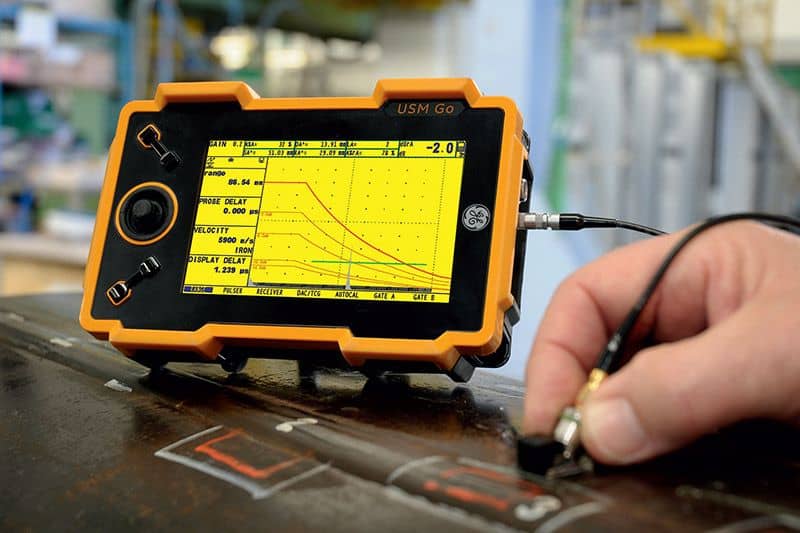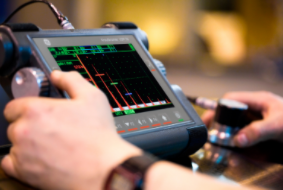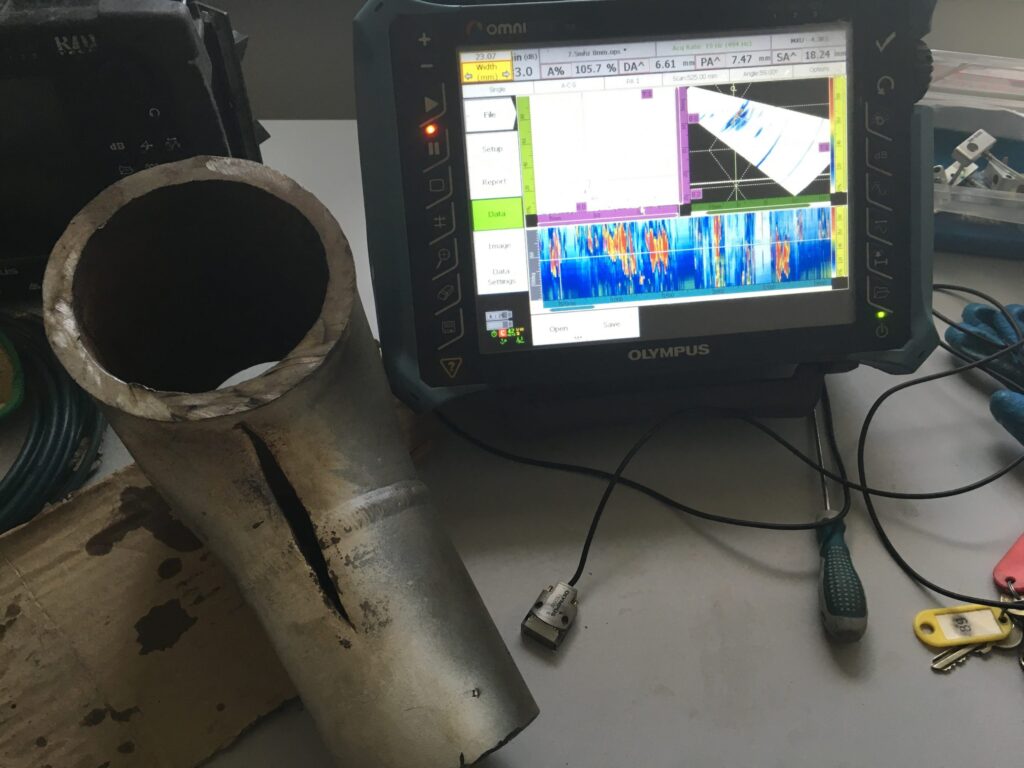The Power of Ultrasonic Testing UT in NDT: Unlocking Hidden Insights for Quality Assurance

Ultrasonic testing (UT) has emerged as a powerful technique in the field of non-destructive testing (NDT). This technology utilizes high-frequency sound waves to detect flaws, measure thickness, and analyze material properties in a wide range of industries. From aerospace to manufacturing and oil and gas to healthcare, ultrasonic testing plays a vital role in ensuring the integrity and quality of various structures and components. In this article, we will explore the key points about ultrasonic testing and its significance in today’s world.

- Principles of Ultrasonic Testing: Ultrasonic testing operates on the principle of sound wave propagation. A transducer generates high-frequency sound waves that penetrate the material being tested. These waves reflect back when they encounter interfaces, such as boundaries, cracks, or inhomogeneities within the material. By analyzing the reflected waves, technicians can determine the presence, location, size, and characteristics of defects.
- Non-Destructive and Versatile: One of the major advantages of ultrasonic testing is its non-destructive nature. It allows for thorough inspection without causing any damage to the tested material. This makes it an ideal method for quality assurance, as it can be performed during production processes, as well as for periodic inspections and maintenance. UT can be applied to a wide range of materials, including metals, plastics, composites, ceramics, and more, making it a versatile technique.
- Detecting Internal and Surface Defects: Ultrasonic testing excels in detecting both internal and surface defects. It can identify discontinuities such as cracks, voids, delaminations, and inclusions within the material. By selecting appropriate transducer configurations and testing techniques, technicians can tailor the inspection to target specific types of defects, ensuring a comprehensive assessment of the material’s quality.
- Precise Measurement Capabilities: Beyond defect detection, ultrasonic testing offers precise measurement capabilities. Ultrasonic thickness gauging enables technicians to accurately measure the thickness of materials, such as pipes, tanks, and structures, without requiring access to both sides. This information is crucial for evaluating corrosion rates, monitoring structural integrity, and determining the remaining life of components.
- Advanced Imaging Techniques: With the advancement of technology, ultrasonic testing has evolved to provide detailed imaging capabilities. Ultrasonic phased array testing utilizes multiple transducers to steer and focus the sound beam electronically. This enables the creation of cross-sectional images, which enhance defect characterization, allowing technicians to evaluate flaw dimensions, orientations, and connectivity more accurately.
- Wide Range of Applications: The applications of ultrasonic testing span various industries. In aerospace, UT is employed to inspect aircraft components, such as wings, engine parts, and landing gear, ensuring their structural integrity. In the oil and gas industry, it plays a vital role in inspecting pipelines, pressure vessels, and storage tanks for corrosion, erosion, and cracks. UT is also used in the automotive sector, power generation, manufacturing, and healthcare, among others.
- Compliance with Industry Standards: Ultrasonic testing adheres to stringent industry standards and codes, ensuring reliability and consistency in the inspection process. Organizations such as the American Society for Testing and Materials (ASTM) and the American Society of Mechanical Engineers (ASME) have developed guidelines that outline procedures, equipment calibration, and acceptance criteria, enabling standardized and reliable inspection practices.
Advantages of Ultrasonic Testing in NDT:
Ultrasonic testing (UT) offers several advantages over other non-destructive testing (NDT) methods. Here are some key advantages:
- Depth of Penetration: Ultrasonic waves have the ability to penetrate deep into the material being tested. This allows for the detection of defects and flaws that may be located beneath the surface. Compared to other NDT methods such as visual inspection or magnetic particle testing, UT provides a more comprehensive evaluation of the material’s internal structure.
- High Sensitivity to Small Defects: Ultrasonic testing is highly sensitive and can detect small flaws and defects, even those that are not visible to the naked eye. This sensitivity makes UT particularly useful for applications where the detection of small cracks or discontinuities is critical, such as in aerospace or nuclear industries.
- Quantitative Measurement: UT provides quantitative measurements, allowing technicians to obtain precise data regarding the size, depth, and orientation of detected defects. This information is crucial for assessing the severity of flaws and determining whether they meet acceptable standards or require further investigation or repair.
- Versatility: Ultrasonic testing can be applied to a wide range of materials, including metals, plastics, composites, ceramics, and more. It is not limited by material type or shape, making it a versatile method that can be utilized in various industries and applications.
- Real-Time Inspection: UT allows for real-time inspection, providing immediate feedback and results. The ability to receive instant feedback enables technicians to make quick decisions regarding the integrity of the material being tested. This is particularly valuable in time-sensitive situations or when conducting in-line inspections during production processes.
- Non-Destructive Nature: Unlike destructive testing methods that require the removal of samples for analysis, UT is non-destructive. It does not cause any damage to the material being tested, allowing for repeated inspections without compromising the integrity or functionality of the component or structure.
- Imaging Capabilities: Ultrasonic testing offers advanced imaging techniques, such as phased array and time-of-flight diffraction (TOFD), which provide detailed visual representations of the inspected material. These imaging capabilities enable technicians to accurately locate and characterize defects, facilitating more informed decision-making and enhanced defect analysis.
- Portable and Field Applicable: Ultrasonic testing equipment is available in various sizes, including portable and handheld devices. This portability allows for on-site inspections, making UT suitable for field applications and remote locations where transporting large or heavy equipment may not be feasible.
- Standardized Procedures: UT benefits from well-established industry standards and guidelines, ensuring consistent and reliable inspection practices. Standards developed by organizations like ASTM and ASME provide clear procedures, equipment calibration requirements, and acceptance criteria, promoting uniformity and comparability in inspection results.
Overall, the advantages of ultrasonic testing, including its depth of penetration, high sensitivity, quantitative measurements, versatility, real-time inspection capabilities, non-destructive nature, imaging capabilities, portability, and adherence to industry standards, make it a preferred choice for many industries requiring accurate and reliable defect detection and characterization.
Conclusion:
Ultrasonic testing has become an indispensable tool for quality assurance and defect detection across a wide range of industries. Its non-destructive nature, versatility, precise measurement capabilities, and advanced imaging techniques make it a preferred choice for ensuring the integrity and reliability of critical components. As technology continues to advance, ultrasonic testing will continue to evolve, providing even greater insights and contributing to the overall safety and efficiency of industrial processes.
For more information, please visit our Ultrasonic Testing Group or UT NDT Forum section.





Responses